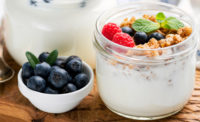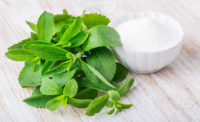Cultures and enzymes are the “secret ingredients” behind many of consumers’ favorite dairy products. They can influence attributes ranging from taste and texture to mouthfeel and shelf life.
Cultures most commonly are microorganisms used to make fermented dairy products such as yogurt, cottage cheese, and buttermilk, but also are capable of performing other functions. For example, Shirley Irvine, director of food industry sales for Boucherville, Quebec-based Azelis Canada Inc., notes that her company offers the protective Holdbac cultures, which inhibit yeast and mold growth to help dairy processors reduce spoilage in fermented products.
And cultures also can help to increase viscosity or sweetness without the addition of sugar, explains Mara York, category sales manager for The Ingredient House, Southern Pines, N.C.
For their part, enzymes most commonly are used for lactose-free milk production (lactase) and enzyme-modified cheese flavors (proteases and lipases), says Christina S. Barsa, CFS, technical sales representative for New York City-headquartered Enzyme Development Corp. However, like their culture cousins, they are capable of accomplishing other tasks.
“The use of enzymes for dairy products has grown, and [enzymes] are being used in other applications such as the production of galactooligosaccharides and accelerating the aging of cheese,” Barsa notes. “Thistle rennet, when used in combination with another rennet, can help produce a cheese with the flavor of a long-aged cheese in a fraction of the time. The application is similar to the use of proteases for enzyme-modified cheese flavors, but the end product is a commercial cheese rather than a flavor slurry.”
Today’s cultures and enzymes can be invaluable when it comes to dairy product innovation and product enhancement. Moreover, by selecting modern cultures and enzymes that are specific to the end result desired, dairy processors are even able to slash research and development time, explains Brian Schlatter, a sales representative for Rimouski, Québec-based Fromagex Inc. — and formerly the head cheesemaker at Old Chatham Sheepherding Creamery in Old Chatham, N.Y.
“Not only have cultures been developed for product flavor attributes; they also are used to help in the safety of the product,” he says.
Slash the sugar
Sugar reduction is one area in which modern cultures could help processors on the innovation front. As Erika Gayhart — associate marketing manager, food cultures and enzymes for Chr. Hansen Inc., Milwaukee — points out, sugar reduction in products such as yogurt is a “top priority” today for both consumers and dairy processors.
“Chr. Hansen offers a comprehensive range of cultures and enzymes solutions in this field,” she says. “Novel and patented cultures enable sugar reduction in fermented milks under the brand Sweety, which enhances sweetness so manufacturers can avoid the use of artificial sweeteners. [And] a large range of lactase enzymes provides cost-effectiveness with an improved sensory profile suiting any yogurt, ice cream or flavored milk process.”
Irvine says Azelis Canada offers Danisco dairy enzymes that allow dairy processors to produce lactose-free dairy products that not only feature sugar reduction, but also prebiotic fiber enrichment.
And New York-headquartered International Flavors & Fragrances Inc. (IFF) offers the Nurica enzyme solutions, which also help dairy processors create lower-sugar, higher-fiber products with a low lactose content, says Rodrigo Magalhaes, global product marketing manager, cultures, and dairy enzymes.
“Nurica minimizes lactose content while generating fiber in the form of galactooligosaccharides, a prebiotic dietary fiber,” he says. “This enzyme [helps] meet two consumer demands: products with higher fiber levels to improve digestibility and products with lower sugar levels, without sacrificing taste of texture of the end product.”
For the lactose-free dairy market, IFF’s Bonlacta enzymes address the processing limitations associated with many commercial enzymes, Magalhaes notes.
“Bonlacta is a high-purity lactase that can hydrolyze lactose faster under refrigeration and high-temperature conditions and delivers a final product with an outstanding clean taste,” he says. “Using this tailored enzyme to produce a lactose-free product, dairy companies can now select their process conditions more freely to minimize reaction times.”
Probiotics, please
Probiotic cultures are on-trend innovation tools, too. Gayhart says Chr. Hansen’s latest consumer research reveals that “science matters to consumers” and that consumers are searching for more healthful food options. What’s more, 88% of surveyed consumers indicated they were familiar with probiotics.
“Of those consumers, only 48% felt they were getting a sufficient amount daily and 78% felt that more products need to be available on the market,” she notes. “Chr. Hansen offers the world’s most studied probiotics, with BB-12 and LGG, among others, that support digestive or immune health.”
The company also launched The Probiotics Institute “in response to consumers’ desire to understand the science behind probiotics,” Gayhart says. The online institute explores the interplay between probiotics and the human microbiome.
Elevate cheese
Modern cultures and enzymes can help bring innovation to the cheese category, too.
For example, some cultures can reduce cheese browning during the commercial pizza-cooking process. By using Chr. Hansen’s Pure Appeal cultures, cheesemakers could produce pizza cheese that reduces browning by as much as 100%, Gayhart explains.
“It also helps protect the cheese naturally from yeast and mold throughout the supply chain,” she adds.
IFF also offers cultures geared toward cheese used in pizza-making operations. Its Choozit BC cultures series helps cheese processors and pizza-makers respond to consumer desire for “more consistent, lighter-colored cheese” atop the pizza, Magalhaes says.
“The Choozit BC cultures offer key advantages, including browning control, better flexibility for pizza baking in oven conveyors, consistent cheese quality with no change in texture before shredding, and water and energy savings — all in a natural, label-friendly solution,” he points out.
Other cultures promise to enhance cheesemaking operations overall. For instance, cheesemakers could use Chr. Hansen’s CHY-Max Supreme coagulant and Easy-Set i400 or Sinergia starter culture programs to increase yield by about 1%, improve slicing and speed up production, Gayhart notes.
“The yield can be pushed beyond this 1% increase by leveraging other specialty enzymes that are offered exclusively by Chr. Hansen to the industry,” she adds.
Speaking of enzymes, they can also work to enhance cheesemaking operations in other ways. For example, they can thin out cheeses, making the cheeses “easier to pump and less likely to stick to the inside of pipes, leading to excessive browning or caramelization during pasteurization,” Barsa notes.
Meanwhile, IFF’s Chymostar — fermentation-produced chymosin — can help cheese processors achieve optimal cheese functionality earlier in the process, with no compromise to texture or taste, Magalhaes says. And when processors combine that enzyme with acidifying cultures such as IFF’s Choozit Swift 600 for pizza cheese, they can significantly reduce the moisture standard variation.
For its part, Azelis Canada supplies dairy enzymes that “give cheese products their defining texture and flavor, while providing advantages in UHT processing,” Irvine says.
Make it premium
Consumers continue to clamor for premium dairy products, and cultures and enzymes can aid in product development here, too. One category of high interest for premiumization is yogurt.
IFF recently launched Yo-Mix Prime cultures to help dairy processors “provide a new level of indulgence in yogurt,” Magalhaes says, “with ultimate mildness and premium texture for consumers.” Yogurt manufacturers could cut formulation costs because they are able to reduce the amount of skimmed milk powder needed to enhance yogurt texture, add less sugar while maintaining the same sweetness perception, and preserve product quality throughout the supply chain.
Chr. Hansen, meanwhile, offers the YoFlex Premium cultures to help yogurt producers create premium, affordable options.
“The YoFlex Premium cultures offer the perfect partnership of high-quality yogurt and a cleaner label, with milder flavors and richer texture,” Gayhart says.
Speaking of flavor and texture, they are critical to both premiumization and successful innovation.
“While the consistency, safety, accessibility, reliability and yield improvement are all important in the manufacturing of dairy products, flavor and texture drive consumers to the product, Schlatter points out.
The right cultures could significantly slash the time required to achieve the desired flavor profile, he explains.
“Texture development can be delayed in other products in order to extend shelf life, thus allowing them to remain on the shelf longer,” Schlatter adds.
Optimize alternatives
Cultures and enzymes can work magic on plant-based dairy alternatives as well. Colline notes that The Ingredient House, for example, offers a unique starter culture capable of fermenting in non-dairy milk alternatives.
Meanwhile, fermented oat beverages could benefit from Azelis Canada’s FoodPro AHT enzyme, which breaks the oat fibers into “milk,” Irvine says.
Azelis Canada also represents IFF’s cultures, she notes, including the premium Howaru probiotics. They are specifically designed to deliver clinically backed health benefits in fermented plant-based products.
“New additions to this range — Howaru Dophilus VG, which contains Lactobacillus acidophilus NCFM, and Howaru Bifido VG, which contains Bifidobaceterium lactis HN019, have highly documented positive results in human studies for digestive health and wellbeing,” Irvine adds.
For its part, Chr. Hansen offers Vega starter cultures, which deliver more choices when it comes to flavor and texture, Gayhart notes.
“As plant-based options continue to capture consumer attention and a growing segment of the market, Chr. Hansen believes that going forward, the category will be led by those producers who are able to offer the best taste, alongside convenience and superior freshness,” she says. “Consumer focus on health, wellbeing and sustainable consumption will only continue to push demand for compelling alternatives within the category.”
Organic, kosher, and other product certifications also are important to certain consumer demographics within the plant-based product space. And Enzyme Development Corp. is going “beyond kosher” with the planned introduction this year of its Kosher for Passover certified papain, Barsa notes.
“This product fills the gap in the enzyme market — where many enzymes are kosher certified, there aren’t many that fit into the market for Kosher for Passover products,” she explains. “Besides being Kosher for Passover certified, it will also be OMRI certified for use in organic processing.”







